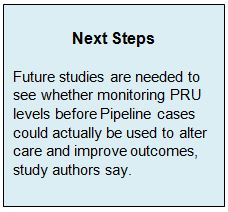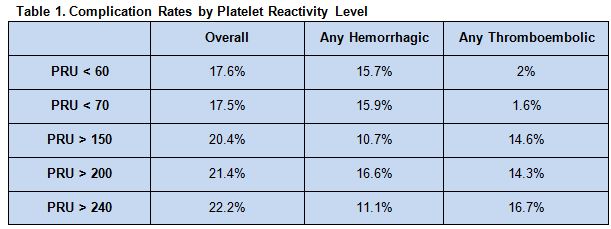Key Points:
- Researchers reviewed data on platelet reactivity in patients treated for cerebral aneurysm with Pipeline device
- Target PRU range of 70 to 150 carries lowest risk of complications
Fewer hemorrhagic and thromboembolic complications occur in patients receiving Pipeline treatment when their P2Y12 reaction unit (PRU) value ranges between 70 to 150, according to research published online January 2016 ahead of print in Neurosurgery.
Pascal Jabbour, MD, of Thomas Jefferson University Hospital (Philadelphia, PA) and colleagues conducted a retrospective analysis of 231 patients (mean age 57 years) who were treated with the Pipeline device (Covidien) in 248 cerebral aneurysms. All patients were started on dual antiplatelet therapy at least 10 days prior to intervention.
Mean last preprocedural PRU was 132 (range, 1-382). Four percent developed major hemorrhagic complications and 5.6% had major thromboembolic complications.
Analysis using Youden indices suggested that the optimal PRU range was 70 to 150 (table 1). Complicates were three times for likely for patients whose values were outside vs inside this range (OR 3; 95% CI 1.2-7.5).
PRU < 60 was a predictor of hemorrhagic complications (OR 2.45; 95% CI 1.01-5.9), and a PRU > 240 carried increased risks of any thromboembolic complication (OR 3.6; 95% CI 1.04-12) as well as cerebral thromboembolic complications (OR 4; 95% CI 1.2-14).
Monitoring individual responses
“The relation between platelet reactivity and thromboembolic and hemorrhagic complications has been studied with the use of coronary and carotid stenting,” write the authors. “Similarly, a wide range of variability in response to clopidogrel has been reported in some of these studies influencing outcomes and complications after stenting.”
“Treatment with the [Pipeline device] requires a preoperative administration of a dual antiplatelet therapy including a P2Y12 inhibitor, mainly clopidogrel and aspirin for about 10 days before the intervention,” they continue. “The individual response to aspirin is somewhat uniform, with only a few patients being poor responders; however, the individual response to clopidogrel varies greatly between different patients. … From this concept stems the importance of monitoring platelet function by using PRU before the intervention.”
Based on the findings of this study, the authors conclude that preoperative PRU values should be targeted between 60 and 240 and ideally between 70 and 150.
“Values below this range carry higher odds of hemorrhagic complications and values that fall above this range carry higher odds of thromboembolic complications,” they say. “Further studies are required to assess the effect of preoperative PRU monitoring on the complication rate of [Pipeline] and to define an optimal range that can be used by all institutions administering this treatment to decrease hemorrhagic and thromboembolic complication rates.”
Source:
Daou B, Starke RM, Chalouhi N, et al. P2Y12 reaction units: effect on hemorrhagic and thromboembolic complications in patients with cerebral aneurysms treated with the Pipeline embolization device. Neurosurgery 2016;Epub ahead of print.
Disclosures:
- Dr. Jabbour is a consultant for Covidien.



